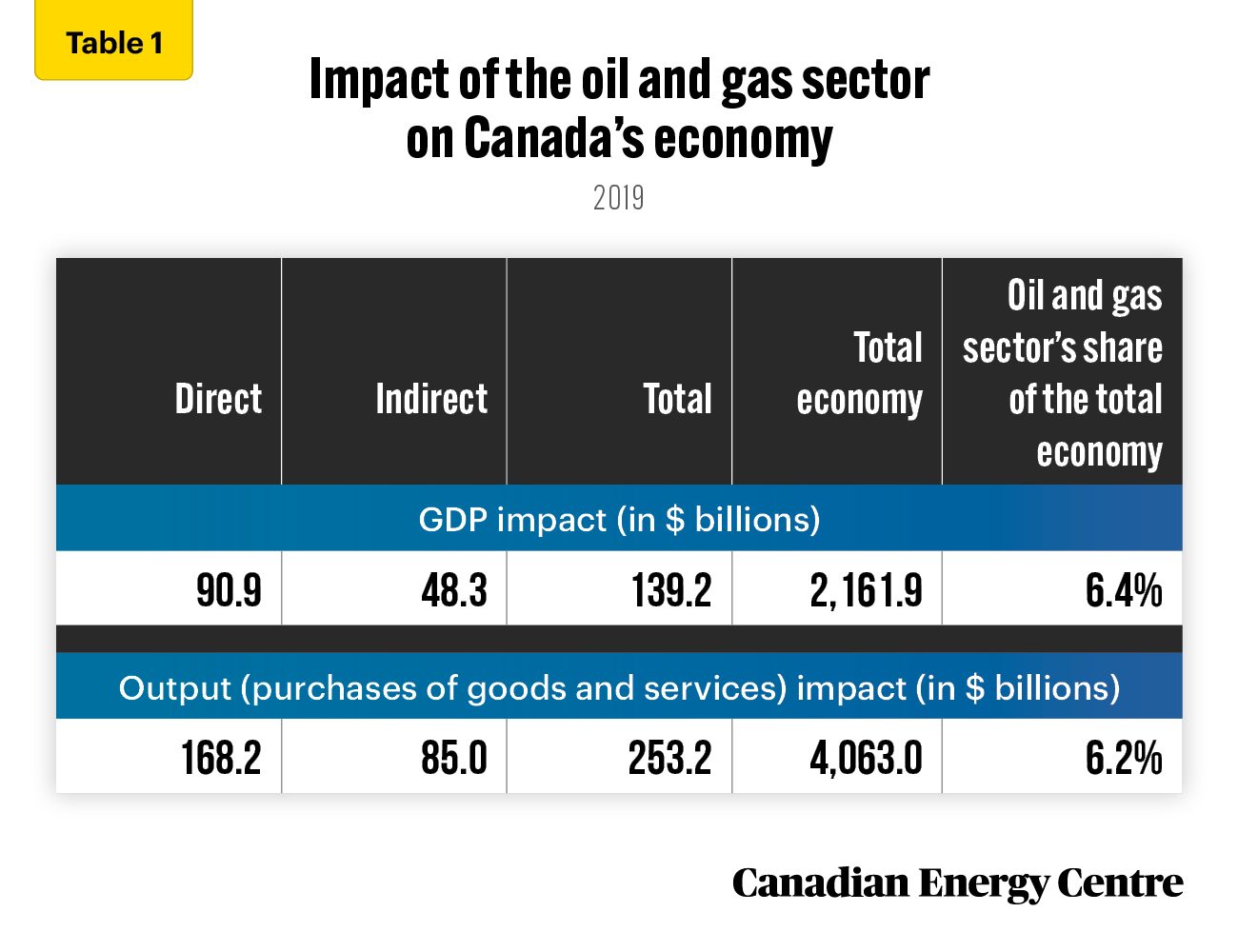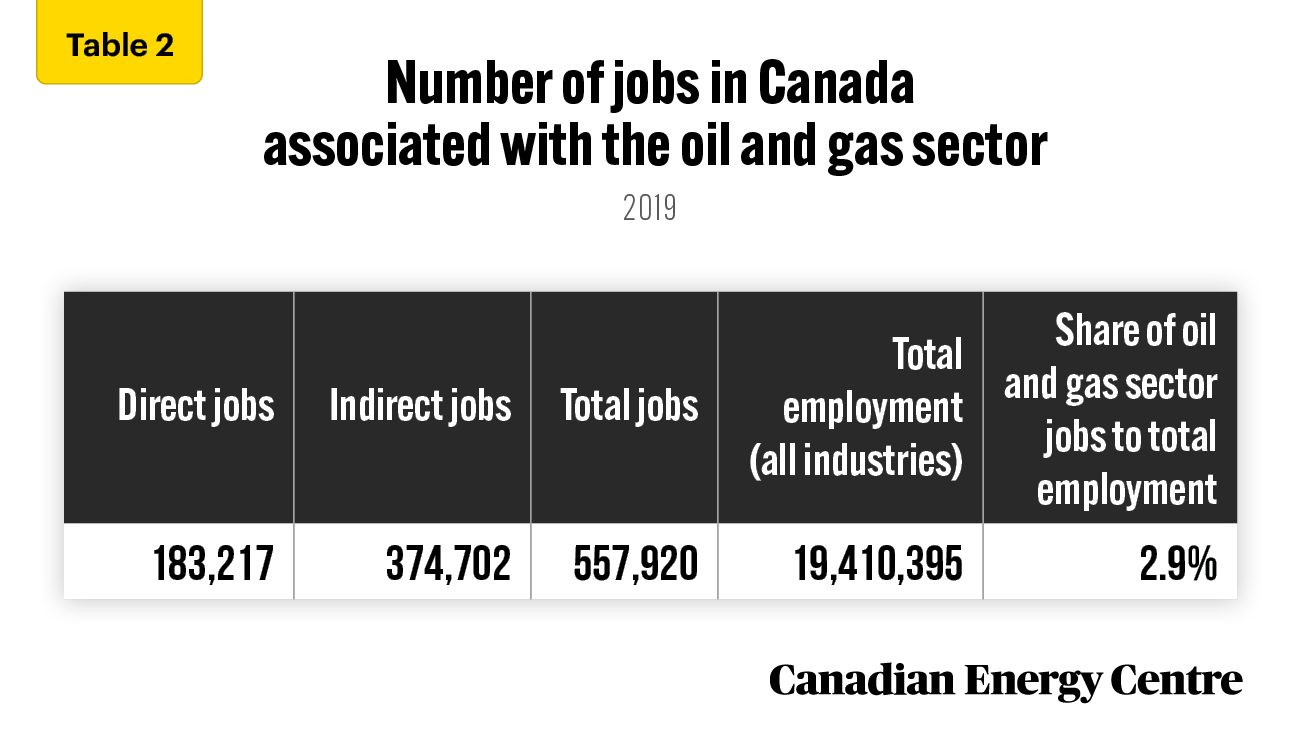To sign up to receive the latest Canadian Energy Centre research to your inbox email: research@canadianenergycentre.ca
Download the PDF here
Download the charts here
Overview
The broad oil and gas sector has been and continues to be a significant contributor to Canada’s economy. Compared to the narrower oil and gas extraction sector, the broad oil and gas sector includes both the direct and indirect impacts on the economy of oil and gas extraction and oil and gas investment.¹
The impact of the broad oil and gas sector on GDP, jobs, and output (the production of goods and services) on key sectors of the Canadian economy is not well known outside that sector or outside regions and provinces where such resource activity occurs. Nonetheless, it is very relevant to current discussions about the important role the sector will play in Canada’s future.
In this Fact Sheet, we examine the impact that the broad oil and gas sector had on Canada’s national economy in 2019. We chose the year 2019 due to the availability of Statistics Canada’s Supply and Use data. The Supply and Use tables (SUTs) provide a detailed accounting of the Canadian economy and give information by industry, products, provinces, sectors, and components of final use.
The analysis presented here includes not only the oil and gas sector’s direct impact on the overall Canadian economy in nominal GDP, jobs, and output, but also the indirect impact that such activities have on other key Canadian industries.
1. See “Definitions” at the end of this Fact Sheet for what is included in this sectoral measurement.
Economic Impacts
As the data show, despite the dip in oil and natural gas prices between 2014 and 2019, the oil and gas sector’s direct and indirect contribution still produced many positive effects for Canada’s national economy. We list a few of the more important effects below.
GDP and output
In 2019, the GDP associated with Canada’s oil and gas sector totaled $139.2 billion, or 6.4 per cent of the total Canadian economy (see Table 1).
In 2019, the output, or value of goods and services that the Canadian oil and gas sector and its supply chain produced, was $253.2 billion, representing about 6.2 per cent of Canada’s total output (see Table 1).

Source: Derived from Statistics Canada, Custom Tabulation of the Supply and Use Tables, 2019
Jobs
In 2019, there was a total of 557,920 jobs associated with the Canadian oil and gas sector—183,217 direct and 374,702 indirect—representing about 2.9 per cent of all jobs across Canada (see Table 2).

Source: Derived from Statistics Canada, Custom Tabulation of the Supply and Use Tables, 2019
Conclusion
The activities of the broad Canadian oil and gas sector are indirectly responsible for sizeable portions of GDP, employment, and output in key industries across Canada.
The impact on the Canadian economy of the broad Canadian oil and gas sector, which includes both the direct and indirect impacts of oil and gas extraction and oil and gas investment, is significant—even with the energy price decline in 2019.
The impact of the broad oil and gas sector amounted to 2.9 per cent of all direct and indirect jobs across Canada that year and made a direct and indirect contribution of 6.4 per cent to Canada’s total GDP.
A primer on the Statistics Canada input/output model and Supply and Use Tables
There has been some debate about the strengths and weaknesses of input/output (I/O) models in assessing the contribution of industry sectors to the Canadian economy. For background on the Statistics Canada I/O model used to arrive at the estimates in this CEC Fact Sheet, we refer to extracts from the following papers by Statistics Canada (2020) and G. Kent Fellows and Jennifer Winter (2018).
From Statistics Canada (2020), Supply, Use and Input-Output Tables:
Input/output (I/O) models are generally used to simulate the economic impacts of the output of one or several industries. The simulation results from a “shock” to an I/O model that will show the direct and indirect and [overall] induced impacts on GDP, which industries benefit the most, and the number of jobs created… The I/O accounts focus on measuring the productive structure of the Canadian economy, and consists of the supply and use tables, among others… These tables can be used to calculate economy-wide gross domestic product (GDP) either directly, by summing value added over the industries, or indirectly, by summing to the economy-wide cost of primary inputs (income-based GDP) or by computing the grand total of the flow of products into final use categories (expenditure-based GDP)… The I/O tables allow the analyst to explore “what if?” questions at a fairly detailed level, exploring the impact of changes in final demand on output while taking account of the interdependencies between different industries and regions of the economy and the leakages to imports and taxes. For example, such models might be used to study the question: “If Canadian oil and gas exports doubled, what industries would be most affected and in which provinces?”
From Statistics Canada Workshop: Statistics Canada’s Input-Output Framework, Input-Output Multipliers and Economic Impact Simulation (March 9-10, 2020):
The supply and use tables represent the most coherent and detailed accounting of the Canadian economy available. Information is provided by industry, products, provinces, sectors, and components of final use… The Canadian input-output framework is an important component of the Canadian System of Macroeconomic Accounts and highly integrated with the Income and Expenditure Accounts… The national input-output tables go back to 1961. The provincial input-output tables go back to 1997… The I/O model and supply and use tables can be used to determine the economic contribution or “footprint” of a given establishment or industry… Statistics Canada’s model is a “pure” InputOutput model and is not a general equilibrium (GE) mode… Perhaps the most significant limitation of I/O is the assumption that extra output can be produced in one area without taking resources away from other activities, thus overstating economic impacts. The actual impact is likely to be dependent on the extent to which the economy is operating at or near capacity… No functions or parameters are included in the I/O model to address the issues related to the constraints of the model…The Statistics Canada model is an excellent Input-Output model that can become the core or basis of a GE model.
A 2018 University of Calgary School of Public Policy paper from G. Kent Fellows and Jennifer Winter, Getting to Know Models: A Primer and Critique on Input-Output and Computable General Equilibrium Models and Their Uses for Policy and Project Analysis, provides the following background on I/O models:
Economic Impact Models (EIA) models can take many forms, but traditionally Input-Output (I/O) models have (been) predominant… I/O models are basically just a bunch of ratios (multipliers) that relate final demand in any sector to all of the initial inputs required to produce that final demand… I/O models remain ubiquitous because they are easy to access, easy to use… In Canada, the StatCan I/O model is widely employed… StatCan conducts approximately 100-125 runs per year… At some point (late 1990s?) [sic], the goal or use of I/O based economic impact assessments seems to have shifted from “distribution and planning” to “magnitude of the impact” (specifically on labour)… I/O models have come under criticism due to a view that the underlying assumptions are unreasonable and the results are often misinterpreted…
By comparison Computational General Equilibrium (CGE) models are generally presented as more reasonable abstractions. Yet both rely on similar structures and are calibrated using similar (if not identical) datasets… Despite what we might deem as unrealistic assumptions, the I/O model (without induced effects) can generate results similar to a Computable General Equilibrium (CGE) model and is still (in my opinion) a useful model. For small shocks, the difference can be quite small for overall GDP. From a starting point at initial equilibrium, I/O is almost a linear approximation of CGE. I/O models are also relatively adept at identifying the distribution of induced demand across other sectors… I/O results should generally be interpreted as a gross effect, not a net effect. I/O results are more likely to produce a “rising tide lifts all ships” result. A positive shock is accommodated with new labour, capital and resources, so there is no competition for factors of production (or any other input). If significant resources are unemployed/idle, IO and CGE models should produce similar and reasonable projections. CGE models are closer to established economic theory and are more internally consistent (and consistent with contemporary economic theory) in their assumptions. Use of a CGE model requires lots of assumptions (factor supply functions). Modelers have discretion in which assumptions they rely on. This flexibility is both a benefit and a liability of CGE models.
Notes
This CEC Fact Sheet was compiled by Lennie Kaplan at the Canadian Energy Centre (www.canadianenergycentre.ca). The author and the Canadian Energy Centre would like to thank and acknowledge the assistance of two anonymous reviewers in reviewing the original data and research for this Fact Sheet.
Methodology
The estimates presented in this paper are the result of a Statistics Canada custom tabulation of the Canadian oil and gas sector taken from the Supply and Use tables (SUTs). The SUTs capture and present the production of products by domestic industries, imports of products as well as their use, either as inputs, final consumption, investment, or exports. The latest SUTs are for the 2018 calendar year. The total (direct and indirect) impact of the oil and gas industry on the Canadian economy can be quantified using input-output multipliers derived from the SUTs. According to Statistics Canada, these multipliers “provide a measure of the interdependence between an industry and the rest of the economy” (Statistics Canada, 2018, National and Provincial Multipliers, Surveys and statistical programs, Documentation: 15F0046X). As Statistics Canada notes, although there is a lag from the 2019 data, the structure of the Canadian economy evolves slowly, so the lag should have a minimal impact on the estimates of GDP, jobs, and output (Statistics Canada, Economic Insights, 11-626-X, No. 109, The Decline in Production and Investment in Canada’s Oil and Gas Sector and its Impact on the Economy, July 2020). This Fact Sheet applies the same concepts and definitions of oil and gas extraction activities as used by the North American Industry Classification System (NAICS), Canada 2012. The Canadian SUTs use the Supply and Use Product Classification (SUPC) system, a variant based on the North American Product Classification System (NAPCS), to classify products within the economy.
Definitions
Using Statistics Canada terminology, we define the broad Canadian oil and gas sector as the sum of oil and gas extraction (NAICS 211) and oil and gas investment. For the purposes of NAICS and NAPCS, oil and gas extraction comprise establishments primarily engaged in operating oil and gas field properties. Such activities may include exploration for crude petroleum and natural gas; drilling, completing, and equipping wells; operating separators, emulsion breakers, desilting equipment, and field gathering lines for crude petroleum; and all other activities in the preparation of oil and gas up to the point of shipment from the producing property. This subsector includes the production of oil, the mining and extraction of oil from oil shale and oil sands, and the production of gas and hydrocarbon liquids, through gasification, liquefaction, and pyrolysis of coal at the mine site. Oil and gas investment includes capital expenditures on construction, machinery and equipment, and exploration by the oil and gas extraction industry. GDP is defined as the unduplicated value of the goods and services produced in the economy. Output consists primarily of the value of goods and services produced by an industry. Jobs include employee jobs (full-time, part-time, and seasonal) and self-employed jobs. The direct impact of oil and gas extraction is the effects directly attributed to this industry’s production. The direct impact of oil and gas investment is the deliveries by domestic industries to satisfy capital expenditures by the oil and gas extraction industry. The indirect impact covers upstream economic activities associated with supplying intermediate inputs (the current expenditures on goods and services used up in the production process) to the directly affected industries. (Excerpts taken from Statistics Canada, Contribution of the Oil and Gas Sector to the Canadian Economy in 2016, 2020, custom tabulation.)
References (all links live as of March 27, 2023)
Fellows, G. Kent, and Jennifer Winter (2018), Getting to Know Models: A Primer and Critique on Input-Output and Computable General Equilibrium Models and Their Uses for Policy and Project Analysis, University of Calgary, School of Public Policy <https://bit.ly/3mQ9jSY>; Statistics Canada (2018a), National and Provincial Multipliers, Surveys and Statistical Programs – Documentation: 15F0046X <https://bit.ly/32L4L8q>; Statistics Canada (2021), North American Industry Classification System (NAICS), Canada 2017, Version 3.0 <https://bit.ly/3rPAnp3>; Statistics Canada (2020a), Contribution of the Oil and Gas Sector to the Canadian Economy in 2016; Statistics Canada (2020b), The Decline in Production and Investment in Canada’s Oil and Gas Sector and its Impact on the Economy (July), Economic Insights, Catalogue 11-626-X, No. 109 <https://bit.ly/32LbTlb>; Statistics Canada (2023), Custom tabulation of the oil and gas sector derived from the 2019 Supply and Use Tables; Statistics Canada (2022a), Table 36-10-0488-01: Output, by Sector and Industry, Provincial and Territorial (x 1,000,000) <https://bit.ly/31mzCd6>; Statistics Canada (2022b), Table 36-10-0478-01: Supply and Use Tables, Detail Level, Provincial and Territorial (x1,000) <https://bit.ly/3mCm9nt>; Statistics Canada (2022c), Supply, Use and Input-Output Tables <https://bit.ly/2G0S3tk>.
Creative Commons Copyright
Research and data from the Canadian Energy Centre (CEC) is available for public usage under creative commons copyright terms with attribution to the CEC. Attribution and specific restrictions on usage including non-commercial use only and no changes to material should follow guidelines enunciated by Creative Commons here: Attribution-NonCommercial-NoDerivs CC BY-NC-ND.
